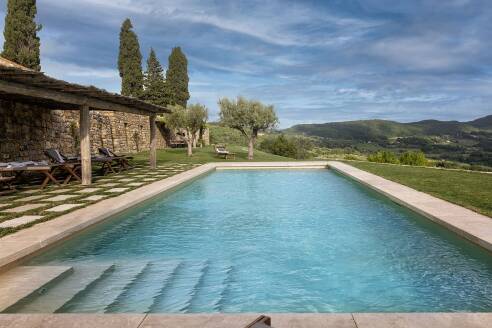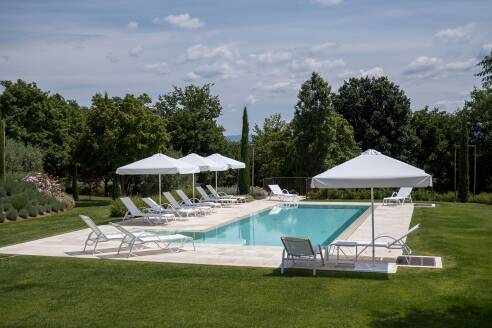- Search magazine...
- Magazine by Category
- Magazine by Region
- article detail
- Search magazine...
- Magazine by Category
- Magazine by Region
- article detail
We continue our journey in Tuscany with ten other destinations that will make you fall in love with this wonderful region, rich in history and culture.
Abbadia San Salvatore
The history of Abbadia San Salvatore is represented by the ancient Abbey dating back to 1035, which is certainly one of the main attractions. The Abbey, located in the center of the town, was for a long time the fulcrum of a great power exercised by the monks in the area.
Abbadia is also popular for having hosted for many years one of the most productive mercury mines in the world, the remains of which are still visible climbing towards the summit of Monte Amiata, just outside the town. The mining activity carried out until the mid-1970s can now be rediscovered in the mining museum park in the town, a destination every year for tourists and students.
Abbadia has recently acquired the name of "City of Torches", for the splendid traditional torchlight procession that takes place on Christmas Eve and which sees the entire village filled with huge piles of lit wood. A tradition that has always attracted thousands of visitors and tourists.

Abbadia San Salvatore
Pontremoli
Pontremoli is the northernmost town in all of Tuscany and one of the most distinctive Lunigiana centers. Built on a plain surrounded by hills and mountains, the town is a tiny treasure trove of artistic and monumental heritage. Simply by crossing its medieval bridges and walking along its streets, you’ll find yourself traveling back in time to a mythical era. It’s actually widely believed by historians that Pontremoli is recognized as the mythical Apua, the ancient capital of the Ligurian-Apuan civilization.
It is no coincidence that the Piagnaro Castle is home to the Museum of the Lunigiana Stele Statues, which holds the incredibly beautiful series of anthropomorphic sculptures that represent the most important evidence of Lunigiana’s history. These works range from the Copper Age to the Romanization era.
The Cathedral is one of the main attractions in Pontremoli’s center; designed in the 17th century by Alessandro Capra of Cremona, it has a Latin-Cross design crowned by a large dome. The interior is illuminated by a spectacular "Ligurian" lighting system and embellished with numerous polychrome marble altars.

Pontremoli
Montecarlo
Montecarlo has nothing to do with the noblest town on the Côte d'Azur. It is a small village among the hills, in the province of Lucca, located at the top of the “Colle del Cerruglio”. The Cerruglio Fortress has a triangular shape and the oldest sections consist of a tower with a semicircular and crenelated structure, the Torre del Maschio and two twin towers, the Torre dell’Apparizione and the Torre di Santa Barbara.
The elegant and well-kept historic center is surrounded by the city walls, still intact today and along which three of the fifteen original gates can still be admired: the original Porta Fiorentina, the main gate from which the road leading to Florence starts, the Porticciola to Lucca, both of the fourteenth century, and the Porta Nuova, to the south, which was reopened in the sixteenth century.

Montecarlo
Barga
Barga is the most important hilltop town in Garfagnana, the area set in northwestern Tuscany in the province of Lucca, famous for its marvelous and varied landscape that offers hundreds of outdoor activities, exploring the territory and its surroundings.
Barga has several civic and religious buildings to visit; the two most important things to see are the Teatro dei Differenti and Casa Pascoli. Both the buildings are related to one of the most renowned Italian poet ever, who considered Barga as his adoptive town: Giovanni Pascoli.
He was buried in the city after he died in Bologna in 1912, in the Chapel next to Casa Pascoli. This house is situated in Castelvecchio Garfagnana, near Barga, where Giovanni Pascoli lived for about 17 years. Now it’s a museum open to the public, still preserving some works of the poet, as well as his antique furnishings and decorations. The Teatro dei Differenti it’s the theatre where Giovanni Pascoli pronounced his famous speech in favor of the Lybian war in 1911.

Barga
Montefioralle
Montefioralle, with its history, its medieval architecture, the alleys, the squares, the church of Santo Stefano, the ancient walls and the castle, is a piece of that rich Italian heritage, made of history, culture, environment and traditions. It is located on a hill overlooking the high valley of the Greve River and the ridge of the Chianti mountains. From the castle passes the road that connects the valley floor to the so-called "Strada dei Poggi", from where the view sweeps west to the Val d'Elsa and the towers of San Gimignano, and north to the Florence basin and the hill on which it stands Fiesole. Here you can admire glimpses of rare beauty, among the splendid vineyards, the woods on the top of the hills and the farmhouses scattered around the farms.
Anghiari
The ancient castrum of Anghiari is a fortified village that dominates the entire Valtiberina. The mighty monastery of San Bartolomeo, transformed by the Perugians into a defensive building due to its characteristics, is the first building in Anghiari to be built together with the Church of the Badia, a place of Christian worship.
The high walls that surround Anghiari have protected and preserved the historic center over the centuries and are almost intact, opening to the outside through three doors: Sant'Angelo, San Martino and Fiorentina. The ancient Piazza del Borghetto, now Piazza Mameli, is an obligatory crossroads for those who venture into the alleys of the Borgo and home to two important museums for the conservation of the memories of the land of Anghiari.
The Palio della Vittoria was (and is) the Palio of Tuscany, and has been running since 1441. To celebrate the Battle of Anghiari, it was also held at the same time in Florence, from Corso de 'Tintori to the Arco di Sanpierino. At sunset, every 29th June, the time of the Palio della Vittoria will always strike. After the announcement of the Challenge, the procession, opened by the Mayor and the Banner of Anghiari, will head to the Cappella della Vittoria where, at 8.15 pm, the firing of the bomb will start the epic challenge between the runners: 1440 meters uphill, at breakneck speed to Piazza Baldaccio. The prize will be the Palio, which will decorate the winning municipality.

Anghiari
Talamone
Talamone is a charming village in Maremma, located on the southern border of the Uccellina mountain range. Characterized by its ancient fortress built for the Aldobrandeschi family, this small village oversees the beautiful Silver Coast and reflects onto the crystal blue water of the Tyrrhenian Sea. Legend has it that the name Talamone comes directly from the Greek hero Telamon, son of Aeacus and Endeïs, brother of Achilles' father, Peleus. It says that Telamon landed here on his way back from Calabria and he is buried right under the fortress.
The village is famous because Garibaldi stopped here during the Expedition of the Thousand. It is a magical place that offers pleasant views of the marina. Its sandy beaches are bordered by pine woods and characterized by crystal clear waters of intense blue color. The bay of Talamone is also famous for sailing sports. It is the perfect location to practice windsurfing, kite-surfing, and sailing. From here you can leave for an excursion to the nearby Maremma Regional Park.

Talamone
Massa Marittima
Massa Marittima is a town north of Grosseto, the main center of the Metalliferous Hills. The medieval village of Massa Marittima is divided into three different neighborhoods or “Terzieri”: “Città Vecchia”, “Città Nuova” and “Borgo”. Città Vecchia, the Old Town, develops around Piazza Garibaldi, where all the most important public buildings were built. The Città Nuova is the upper part of the city center: there you can find the Sienese Fortress and the Torre del Candeliere. The lowest medieval neighborhood is Borgo, with its Palazzo della Zecca. Visit the magnificent Cathedral of San Cerbone, the Fonte dell'Abbonanza and the Tree of Fertility. But don't miss the Archaeological Park of the nearby Lago dell'Accesa and the Mine Museum.
Montecatini Terme
Montecatini Terme is in the center of Tuscany, a short distance from Florence and the Tyrrhenian Sea, at the foot of an amphitheater of green hills that prelude the Apennines and in the center of an artistic area of exceptional importance. The town owes its popularity to the thermal waters, probably known and exploited at the time of the Romans, rich in precious mineral elements. The waters of Montecatini are various and have diversified indications. The traditional thermal water and mud are also combined with the most innovative methodologies of wellness and beauty: massages, body and face treatments, slimming, relaxation programs.
The park is also worth a visit; it is a vast natural area (about 75,000 square meters), a wonderful green lung in the center of the city and an ideal setting for spas.
The spas, true architectural and artistic masterpieces, together with the Art Nouveau buildings and the works of modern internationally renowned artists, constitute a true open-air museum.

Montecatini Terme
Poggibonsi
Poggibonsi is a small town located in the Alta Valdelsa, in an important strategic point because it is easily reachable from Rome and most of the Tuscan cities. It preserves important monuments and ancient works of art, found in its territory. Here passed the Romans, the Lombards and the Carolingians.
Among the most interesting monuments to see in Poggibonsi you can find the Collegiata (Collegiate Church), the Chiesa di San Lorenzo, the Chiesa di San Lucchese, the Poggio Imperiale and the Palazzo Pretorio.
Start planning your Tuscan vacation and book one of our luxury villas for rent in Tuscany!
Copyright © Home in Italy. All rights reserved.
camilla

10 5 6
Tuscany, Capalbio
from 20,000 to 32,500 € / week
dalmata

18 9 9
Tuscany, Panzano In Chianti
from 16,500 to 20,000 € / week
iride

10/12 5 10
Tuscany, Barberino Tavarnelle
Price On demand
pratolino

12 6 7
Tuscany, Fiesole
from 17,000 to 22,000 € / week
villa serenella

12/17 6 11
Tuscany, Foiano Della Chiana, Cortona Area, Arezzo Area
from 9,100 to 14,000 € / week
villa monteca

12 6 6
Tuscany, Montecatini Terme
from 13,350 to 19,300 € / week
pallade

14 7 5
Tuscany, Castelfalfi
from 13,550 to 21,100 € / week
villa perline

10 • 14 7 8
Tuscany, Gaiole In Chianti
from 13,100 to 27,250 € / week



